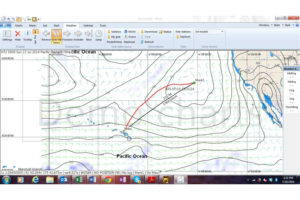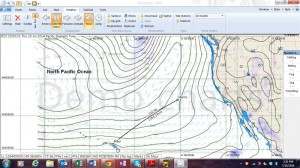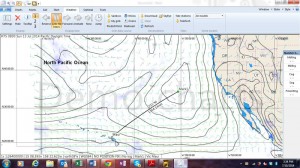For the boats in the first start, we are now 7 days into the race and 5 days for the second start. Life on board should have fallen into a rhythm for the crews. Hopefully those that felt squishy from motion sickness are feeling better. The strong NW winds will have likely taken their toll, both on equipment and on people. Getting sleep when the boat is juking about in the waves with the ever present danger of broaching, especially at night, can be hard. By day 7 it really can catch up to you. With lack of sleep folks tend to get crabby and tempers can flare on board. In aggressive sailing conditions, it’s likely most on board haven’t had a chance for shower yet as well and things start to smell ripe. Sounds fun huh?
Call me crazy, but I can say I most definitely wish I was there! It’s hard to explain to those who haven’t been. The ocean, the sky and clouds can be incredibly beautiful. Not to mention the sunrises and sunsets. Your world shrinks down to the very immediate needs of the 38’ to 50’ platform you are sailing aboard. All the land borne concerns tend to drift away. Yes people may get crabby, but you also get to know the people around you on a much deeper level, especially the folks you stand watch with. If the clouds clear out, the night watches are amazing. With no light pollution the stars and planets are all out in their glory. Hopefully your are on a boat with a good stereo system, playing Pink Floyd’s “Dark Side of the Moon” during the middle of the night. It’s the best.
Taking a look at the race tracker the fleet is beginning to spread out as competitors try to find the best positions for the coming changes in the weather. Some boats have gybed, sailing more of a SE course. The J-160 Jam has been the most radical with this philosophy. Others have taken short bites, gybing to port before gybing back. On the other hand, Longboard has stayed on starboard and has continued to make money, as they have positioned themselves well to the south of the rest of the fleet. They are looking good. Some of their success can be attributed to raw boat speed, but they deserve credit for holding it all together and for a well executed route thus far. On the other extreme is the Stevens 47, Passerpartout. They did take a gybe earlier in the race but have been sailing hotter angles, recently remaining on starboard tack. They are currently the furthest west in the entire fleet and continue to lead class C. The class B leader, Kahuna, has sailed a more conservative middle of the road route, which has also paid. What this tells me is there has been more than one way to skin a cat. It’s the well prepared, well sailed boats that continue to push, and minimize the down time, that are doing well.
Looking to the future, for the navigators it’s starting to get real. The beds are mostly made and now they are going to have to sleep in them. The Pacific high, which had strengthened earlier in the week, is now weakened substantially and is being smooshed (that is a highly technical meteorological term) by a low pressure system and cold front located to the NW. The high looks more like a pancake, and stretches from the SW to the NE for about a thousand miles. The entire fleet is currently located about 2/3 of the way down the “pancake” on its eastern side. The GFS weather model has the high pressure continuing to weaken and drifting more to the east. By late Saturday the high is forecast to be centered directly over where the fleet currently is. Because the high won’t be all that strong, winds in and around the center will be very light and fluky. The light winds could cover an area roughly 300 to 400 miles across.
This presents a tough nut to crack for the fleet. As I mentioned in my previous update, there are two schools of thought, go west, punch through the high and take advantage of the stronger southerly winds on the backside of the high. Or, stay east and try to get far enough south to avoid the lightest of winds. Many of the slower boats are not going to have a choice. The Pacific high is going to pass over them regardless. Potentially the quickest boats could get far enough south. This looks like what Jam is attempting to do. Longboard, and perhaps New Haven could also try and make this work. So far Longboard hasn’t blinked as they continue on starboard gibe.
 I keep running the routing function on the Expedition software and it continues to route a more westerly course through the high pressure and light winds. Because the high is in motion, the amount of time caught in the lightest conditions should be minimized. As boats make their way west they should eventually pick up winds initially directly from the south. Over time the wind will lift and competitors will be able to point more at the finish line all the while sailing on a hot reaching angle. Those that elect to stay the long route around the bottom of the high pressure could find themselves having to sail deep angles for a thousand miles to Hawaii. Worse, the fleet may not see nice trade wind conditions in the teens to twenties until they get a day or two from the finish. This would favor boats sailing the hotter reaching angles.
I keep running the routing function on the Expedition software and it continues to route a more westerly course through the high pressure and light winds. Because the high is in motion, the amount of time caught in the lightest conditions should be minimized. As boats make their way west they should eventually pick up winds initially directly from the south. Over time the wind will lift and competitors will be able to point more at the finish line all the while sailing on a hot reaching angle. Those that elect to stay the long route around the bottom of the high pressure could find themselves having to sail deep angles for a thousand miles to Hawaii. Worse, the fleet may not see nice trade wind conditions in the teens to twenties until they get a day or two from the finish. This would favor boats sailing the hotter reaching angles.
The race will likely be won or lost over the next 3 days. The boats that navigate the quickest route through the lightest winds and position themselves with the best sailing angle will be the winners. Up until now the fleet has stayed fairly clustered together. I suspect we will see a much larger spread by this time on Monday. It’s all very exciting to watch unfold. If you haven’t already done so check out the fleet on the Race Tracker at the Vic-Maui website.

